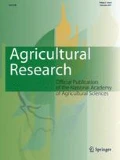Abstract
Consumers demand and desire health foods, which are portable, convenient and proportioned as well. Cereal bars have emerged as an attractive and innovative option for convenience food product. With this aim, energy bar samples were prepared using popped maize flour (12–22 %) in addition to other ingredients such as legume grits, soy protein. Three sweeteners viz. corn syrup (CS), honey (H) and jaggery (J) were used with 45, 50 and 55 % levels. The influence of level and type of sweetener was studied on colour characteristics, cutting strength and sensory characteristics. All the quality characteristics were significantly affected by type of sweetener except for taste score. Further, all the parameters except for aroma and yellowness index were also affected by level of sweetener. The sensory panellists rated the jaggery-based samples superior for all the sensory parameters. The cutting strength was highest for jaggery-based samples. Based upon the sensory evaluation, the sample having 17 % popped corn flour and 50 % jaggery was found most acceptable and analyzed for proximate composition. 100 g of optimised corn-based energy bar provided 9.2 g fat, 12.64 g protein, 3.14 g total minerals, 158.79 mg calcium, 4.114 mg iron and 414.4 kcal energy. The free fatty acid content and microbial load of the energy bar sample was within the acceptable limit for 3 months under refrigerated conditions. Thus, corn-based energy bar is a better choice for a quick meal or snack than a fast food meal and other highly processed packaged convenience foods.






Similar content being viewed by others
References
Akeson WE, Stachman MA (1964) A pepsin-pancreatin digest index of protein quality evaluation. J Nutr 83:257–261
AOAC (2000) Official methods of analysis, 17th edn. The Association of Official Analytical Chemists, Washington
BIS (1971) IS: 6273 Part I and Part II (1971) Guide for sensory evaluation of foods. Indian Standard Institution, Manak Bhawan, New Delhi
Burn D (2007) On the rise. Food Can 67(1):28–32
Cruickshank R, Duguid JP, Marmion BP, Swain RHA (1975) Medical microbiology—the practice of medical microbiology. Churchill Livingstone, Edinburgh
Deshpande S, Bargale PC, Joshi KC, Singh V, Varghese S (2004) Enhancing the nutritive value of barley based sattu by soy fortification. Ind J Nutr Dietet 41(4):146–159
Jaeger SR, Meiselman HL (2004) Perceptions of meal convenience: the case of at home evening meals. Appetite 42(2004):317–325
Mridula D, Rita J, Singh KK (2010) Effect of storage on quality of fortified bengal gram sattu. J Food Sci Technol 47(1):119–123
Mridula D, Singh KK, Barnwal P (2011) Development of omega-3 rich energy bar with flaxseed. J Food Sci Technol. doi:10.1007/s13197-011-0425-x
Nagaraj G (2009) Oilseeds-properties, processing, products and procedures. New India Publishing Agency, New Delhi
Parker ML, Grant A, Rigby NM, Belton PS, Taylor JRN (1999) Effect of popping on the endosperm cell walls of sorghum and maize. J Cereal Sci 30:209–216
Reddy NS, Kamble RM, Khan TNI (1991) Evaluation of nutritional quality of maize and maize products. Ind J Nutr Dietet 98:90–94
Roberfroid MB (1999) Concepts in functional foods: the case of inulin and oligofructose. J Nutr 129:1398s–1401s
Sacilik K, Ozturk R, Keskin R (2003) Some physical proprieties of hemp seed. Biosyst Engg 86(2):191–198
Sharma M, Kadam DM, Chadha S, Wilson RA, Gupta RK (2013) Influence of particle size on physical & sensory attributes of mango pulp powder. Int Agrophysics 27:323–328. doi:10.2478/intag-2013-0001
Thakur BR, Arya SS (1990) Packaging requirements and stability of fried wheat snacks (Trisnacks). J Food Sci Technol 27(2):76–81
Thapar VK, Sehgal VK, Shashi P (1988) Post harvest quality analysis of food grains—research bulletin. Department of Processing and Agricultural Structures, Punjab Agricultural University, Ludhiana, pp 13–14
WHO (2005) World Health Organization: vitamin a deficiency document. http://www.who.int/nut/vad.htm. Accessed 14 July 2011
Author information
Authors and Affiliations
Corresponding author
Rights and permissions
About this article
Cite this article
Sharma, M., Mridula, D. Development and Quality Evaluation of Maize-Based Fortified Nutritious Bar. Agric Res 4, 93–101 (2015). https://doi.org/10.1007/s40003-014-0140-8
Received:
Accepted:
Published:
Issue Date:
DOI: https://doi.org/10.1007/s40003-014-0140-8




